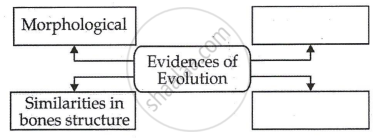Advertisements
Advertisements
प्रश्न
Explain with suitable examples importance of anatomical evidence in evolution.
उत्तर १
Anatomical evidences help us to study how species have evolved over a period of time. Analogous structures support the theory of evolution and explain the fact that how species build up adaptations in order to fit in an environment whereas homologous structures help us to understand common ancestry. For example, if we compare the hands of humans with cat’s foreleg, flipper of whale and patagium of bat, we see that each of these organism use these structures are differently. But still there is a similarity between the structure of bones and joints which indicates that somewhere or the other these animals may have originated from common ancestors. This is an example of homology. Another example which explains analogous features is the arctic fox and the ptarmigan bird, Both of them change colours from dark brown to white during seasonal changes. They do not show common ancestry in way but since, they are found in the same habitat they are adapted to colour change.
उत्तर २
Anatomical evidence is important as a physical proof for evolution. The anatomical evidence are majorly of two kinds:
- Analogous structures: These are structures that have similar functions and appearance but have different biological make-up. This is a proof for evolution that unrelated species, when forced to live in similar conditions, adapted to this but differently. examples- Body shape, size, and colour in sharks and dolphins
- Homologous structures: These are structures with similar biological make-up but different functions. This supports evolution that related species when exposed to different environments, adapted accordingly. examples: Wings of birds and bats.
APPEARS IN
संबंधित प्रश्न
State the connecting links between Peripatus with Annelida and Arthopoda.
What are vestigial organs?
Give two examples of vestigial organs in human beings and plants.
Given below is the list of vegetables available in the market. Select from these the two vegetables having homologous structures:
Potato, sweet potato, ginger, radish, tomato, carrot, okra (Lady’s finger)
(A) Potato and sweet potato
(B) Radish and carrot
(C) Okra and sweet potato
(D) Potato and tomato
With the help of any two suitable examples explain the effect of anthropogenic actions on organic evolution.
Which one of the following pairs of vegetables is an example of homologous structures?
(A) Potato and sweet potato
(B) Carrot and radish
(C) Carrot and tomato
(D) Tomato and radish
Four students P, Q, R and S differently reported the following set of organs to be analogous :
P. Forelimb of a frog and forelimb of a lizard
Q. Forelimb of a bird and forelimb of a human
R. Wings of a parrot and wings of a butterfly
S. Wings of a bird and wings of a bat
The two students who have reported correctly are :
(A) P and Q
(B) Q and R
(C) R and S
(D) P and S
Enlist any four sequential evolutionary names of human ancestors.
Some dinosaurs had feathers although they could not fly birds have feathers that help them to fly. In the context of evolution, this means that ______
The presence of which of the following types of organs in two animals indicates that they are not derived from a common ancestor?
(a) homologous organs
(b) excretory organs
(c) analogous organs
(d) reproductive organs
The presence of which of the following types of organs in two organisms indicates that they are derived from the same ancestor?
(a) analogous organs
(b) respiratory organs
(c) digestive organs
(d) homologous organs
_______ is a connecting link between Annelida and Arthropoda.
Complete the following chart:

With the help of diagrams, describe emasculation and bagging.
Draw a labelled diagram of T.S. of a leaf showing Kranz anatomy.
Choose the correct option of the following question:
Wings of Insect and Birds are examples of :
Differentiate between connecting links and the missing links.
Short answer question.
Give the significance of fossils.
Long answer question.
Would you consider wings of butterfly and bat as homologous or analogous and why?
_____________ is a vestigial organ in human beings.
Find an odd one out.
I am a connecting link between reptiles and mammals. Who am I?
Enlist the evidences of evolution.
Biogenetic law states that ______.
How do you differentiate homologous organs from analogous organs?
Homologous organs and vestigial organs are examples of ______ type of evidence in evolution.
Which of these is not a vestigial organ in human beings?
Where is carbon dating used?
Tendons and ligaments are examples of ______.
Evolutionary convergence is the development of:
Organs having similar functions but different origin and development are known as:
Fossils are generally found in ______.
What are we referring to? When we say 'simple organisms' or 'complex organisms'.
Give an example for convergent evolution and identify the features towards which they are converging.
Complete the following diagram:

Complete the following chart:

I am the connecting link of annelida and arthropoda. What is my name?
Complete the following conceptual picture:

Give examples of homologous organs and analogous organs in plants.
